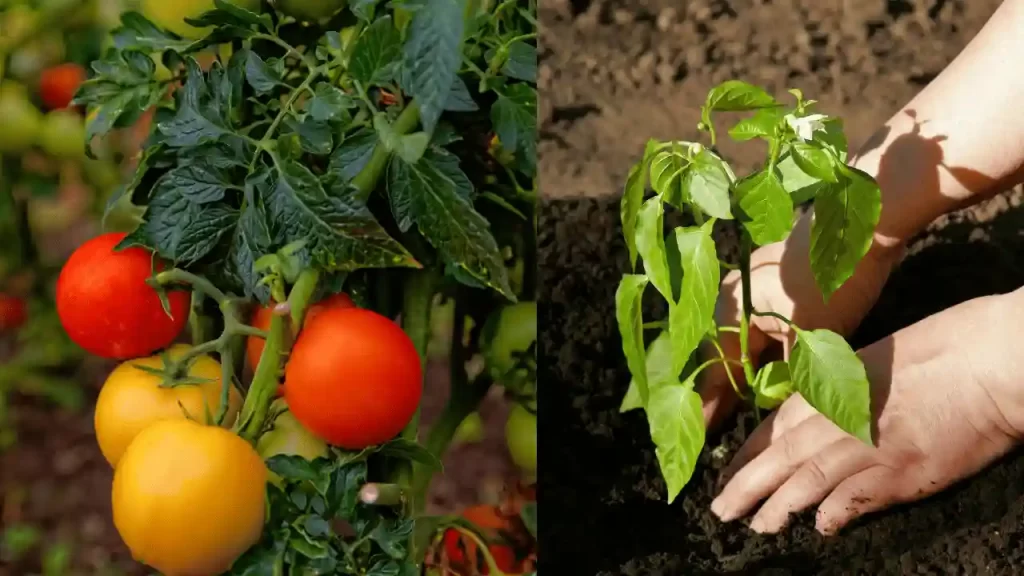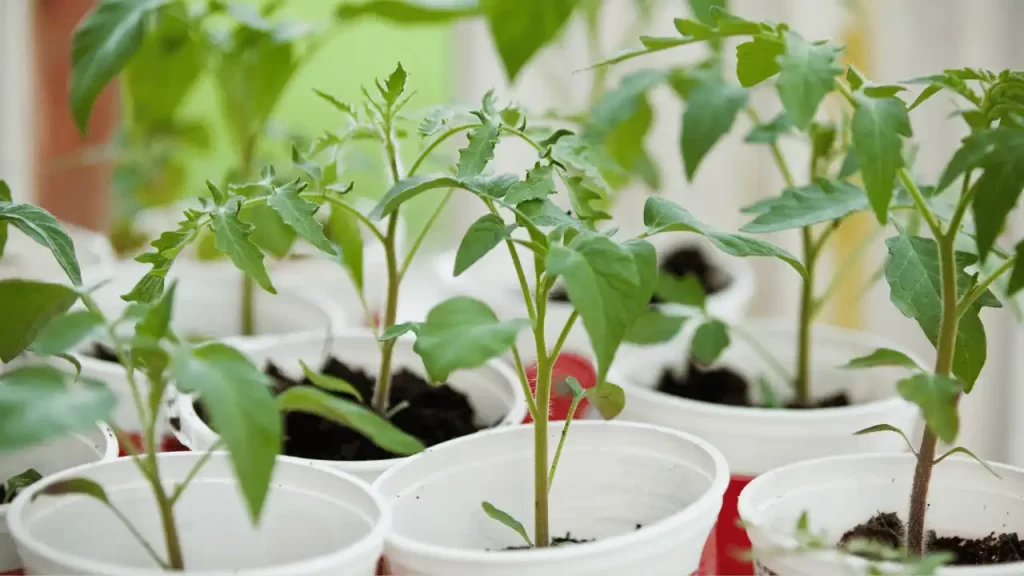It is tough to find the best companion plants for your garden. Most plants get some benefits if grown with some specific plants. Unknowingly, Some plants are grown closer to other plants, which creates many obstacles to growth; sometimes, that plant even dies.
Now the question is, what if tomatoes and peppers are grown together? Will they harm each other, or will they be proved to be advantageous?
Yes, peppers and tomatoes can be planted together. When grown together both of them maximize yields in small spaces, make the soil more fertile and attract beneficial insects as pollinators. You can use a trellis to maximize their yields.
It will act like a miracle if tomatoes and peppers are planted together correctly. But if planted incorrectly, both of them may get destroyed.
Tomatoes should never be grown with potatoes and many other plants, but if you plan to accompany them with peppers, it’s a great idea.
Read this article thoroughly to understand how to plant tomatoes and peppers together and do companion planting works for both the veggies.
Should You Companion Plant Peppers and Tomatoes?

Tomatoes and peppers are proven to be one of the best companion plants if planted by following the proper steps.
You can plant both plants and get a high yield even in limited space if they get nutritious soil and proper exposure to sunlight and water.
Please read below our tips and tricks for growing peppers and tomatoes together.
How To Plant Tomato and Pepper Together?

Tomatoes and pepper thrive better in hot climates, but at the same time, both plants are more prone to fungal diseases. Thus it is very important to mind the space between the plants.
Ensure to maintain at least 18-24 inches of distance between the tomato plants and at least 18 inches for pepper plants. Keep the soil loose to prevent it from clumping with the help of a hoe or gardening rake.
Keep your soil rock free to maintain the growth of the plants. After all these things, your plants are ready to be placed in the rows.
You should maintain 2-3 feet of distance between the rows. It would prevent the unhealthy competition between the plants for nutrition and water.
Related Article – Can You Plant Tomatoes With Cucumbers
Tips To Grow Tomatoes And Peppers Together

Proper spacing between the plants: Ideally, you should maintain 18-24 inches of space between the plants and 2-3 feet between the rows for better yield. For container plants, you can grow peppers and tomatoes together, but the yield will be a little low).
Stakes and trellis: Use tomato cages, posts or twins to provide proper support to the plants.
Pruning: you can prune lower and old tomato leaves of tomatoes to maintain good airflow between the plants.
Fertility: ensure using rich soil for planting tomato and pepper plants to thrive well. You can mix diluted liquid fish or kelp once in 2 weeks in the main growing season.
Add other companion plants: You can also plant herbs like parsley and lettuce as companion plants, along with tomatoes and peppers, for better growth.
Avoid overhead irrigation: Opt for soaker hoses or drip irrigation instead of overhead irrigation. It would not let the water stay on the leaf surfaces, and the plants would be disease-free.
Common Mistakes and Easy Fixes For Growing Tomatoes and Pepper Companion Plants
The gardeners often make a few mistakes while planting both plants. Fortunately, we have some easy fixes to overcome those mistakes.
Planting Too Close Together
Proper spacing between the plants is vital for planting any plants to spread their roots and leaves efficiently.
So maintain an 18-24 inches distance for tomato plants and at least 18 inches for pepper plants. Never plant any plants too close to each other.
Forgetting to Trellis or Stake

There are high chances of falling over for tomato and pepper plants when they set high numbers of fruits during summer.
Thus staking and trellising becomes the utmost important thing to reduce the risk of getting damaged.
Ensure staking and trellis for both the plants, or else all your hard work for planting both the plants together would go in veins.
Avoiding Pruning

Pruning involves cutting lower old leaves and suckers to maintain good plant airflow. But avoiding pruning can be great for planting tomatoes and peppers together.
Suckers are small shoots or leaves which come out from the main stem and branch and form a V shape and they are very important for tomato plants.
You should prune suckers for higher yield and to prevent disease issues. Thus, only one or two main shooters that grow efficiently upward and out are left.
Not Enough Nutrients

Tomatoes and peppers both are prolific plants, and both are heavy feeders too. Thus you need to be very specific about the soil used for planting.
Use high-quality compost and organic fertilizers like bone meal or fish emulsion at the peak of the growing season.
The same fertilizers can be used for peppers too. This is also one of the reasons for growing both plants; they are proven to be one of the best companion plants.
Disease

When you notice early or late blight in your plants, remove them immediately to reduce the risk of spreading the disease. (Source)
You can also use diluted neem solution to treat or organically prevent your plant from fungus or pathogens.
Please ensure to maintain good air circulation between the plants. You can prune the old lower leaves of the plants.
Pests

Tomatoes and peppers belong to nightshade family and are more prone to attract insect pests. Tomato hornworms (sometimes also called tobacco hornworms) are the most common ones.
They are green-colored 8-10 feet caterpillars which can even be hand-picked and removed if spotted. They can simply eat all your plants and fruits just in one day. So be very cautious and act proactively when spotted.
You can also use light row cover when the plants are young at the beginning of the plantation to keep these destroying caterpillars far away from your garden.
It also provides extra warmth to your plants, which favors your plant’s growth and repel pests.
Can you plant pepper and tomato in the same bed?
Yes, you can plant both pepper and tomato plants in the same bed. Peppers and tomatoes are both members of the nightshade family, which means they have similar soil and sunlight needs. However, there are a few things to consider before planting them together.
First, peppers take longer to mature than tomatoes do so it’s important to plant them early in the season.
Secondly, tomatoes are heavy feeders and will compete with peppers for nutrients if they’re not given enough fertilizer.
Finally, peppers are more sensitive to temperature extremes than tomatoes are, so it’s important to protect them from extreme heat or cold.
Summary
It is very advantageous and easy growing tomatoes and peppers together as companion plants. You can even pair both of them to prepare delicious recipes. These plants fit best together in your garden. Ensure to follow the steps mentioned above for healthy and easy panting. Ultimately, you can get a higher yield for tomatoes and pepper.
Frequently Asked Questions
What should not be planted with tomatoes?
You should not plant tomatoes with Cabbage, broccoli, cauliflower, kale, Brussels sprouts, and kohlrabi. These vegetables can draw away essential nutrients from the tomatoes and stunt their growth. As a result of this competition, tomato plants may produce fewer fruits.
How far apart to plant tomatoes and peppers?
You should plant tomatoes and peppers at least 18-24 inches apart. When planting more than one row of tomatoes or peppers, the rows should be placed 3-4 feet apart to allow for proper air circulation.
In addition, it is important to remember that some tomato and pepper varieties can grow quite large, so that they may require more space than the recommended spacing.
What can you not plant with peppers?
You should not plant peppers with cabbages, broccoli, cauliflower, kale, kohlrabi etc., as these plants are all susceptible to the same diseases and pests.
Also, you must avoid planting peppers with cabbage family members (broccoli, cauliflower, kale, etc.) because they can cross-pollinate and plants of the same family are known to draw out similar nutrients from their environment.
Finally, do not plant peppers near fennel or dill; they can also cross-pollinate with peppers.
Instead, opt for companion plants such as garlic, basil, oregano and parsley which help improve the flavor of peppers.
Can I plant jalapenos next to tomatoes?
Yes, you can plant jalapenos next to tomatoes. Some gardeners even recommend planting them together as they are both in the same family of vegetables (nightshades) and share similar growing needs.
The jalapenos may even ward off pests that could damage your tomato plants.
What month do you plant tomatoes and peppers?
The best time to plant tomatoes and peppers is in the late spring or early summer when soil temperatures have warmed up, and all danger of frost has passed. Generally, this means planting them around May or June in most areas.
However, you can start certain varieties indoors several weeks earlier if your area experiences long cold winters.
Be sure to check the guidance on specific tomato and pepper varieties you plan to grow, as each variety may have different requirements for when you should plant it.
It’s also important to research your local climate conditions and temperature ranges to ensure that you are planting at the best time for your location.
